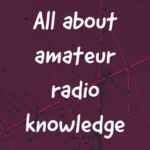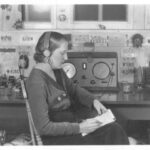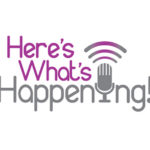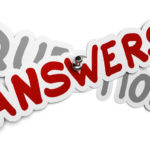The TAG (TN, AL, GA) Net
 Join Terri Perdue, N9ZEN as Net Control and get in on the fun!
Join Terri Perdue, N9ZEN as Net Control and get in on the fun!
This Net is an open Net and is not affiliated with any club – we are focused on the community the hobby creates.. All YL’s everywhere are welcome and encouraged to join us! And OM’s, we appreciate your support and behind the scenes help, so please keep listening in!! We are a small group of YL’s and we are growing! We meet on the air and off, for fellowship, fun, technical and emergency preparedness training. We for the most part follow the schedule below, but may change it a little if needs arise for special topics.
The Net is held every Monday evening beginning at 2000 (8pm eastern time) and generally last 60 to 90 minutes.
Don’t forget that you have many ways to connect with the TAG YL Net!
Repeaters:
- W4GTA 145.350 repeater on Lookout Mountain in GA
- N4LMC 144.920 repeater on Signal Mountain in TN
- N4LMC 146.640 repeater on Signal Mountain in TN
- N4LMC 224.120 repeater on Signal Mountain in TN
- N4LMC 224.560 repeater on Lookout Mountain in GA
- N4BZJ 224.680 repeater on Dug Gap Mountain in GA
- W4KEV Repeater systems throughout E TN
- Multiple repeaters throughout Georgia (via the *GEORGIA* Conference Server)
Allstar:
- N4LMC Allstar Node 46331
Amateur Wire:
- Extension 90013 – W4GTA 145.350 Repeater System
Echolink:
- Echolink Conference Server *SELINK*.
- Echolink Conference Server *GEORGIA*
HamShack Hotline:
- Extension 94013 – W4GTA 145.350 Repeater System
HAMs Over IP:
- Extension 15014 – W4GTA 145.350 Repeater System
We want to thank the Tri-States Amateur Radio Club for the 145.350 repeater, N4BZJ for the 224.680 repeater and W4EDP, N9ZEN and the LMARC for the 144.920, 146.640, 224.560 repeaters as well as the 46331 Allstar node and the SELINK Echolink Conference server.
We are always looking for training and emergency preparedness topics. If you have an idea for a topic or would like to present one, just shoot us an email and we will get you signed up!
Net Schedule / Preamble
-
- Welcome and Net Information
- Call for Emergency Traffic
- Call for General Announcements
- Check-ins
- Fellowship
- Tech Talk
- Technical Training Topic
- Emergency Preparedness Training Topic
- Last Call for Comments
- Net Wrap-Up
Don’t forget to follow along online using NetLogger, it’s free and is available for Mac, Linux and Windows (desktops/laptops only, no tablets/phones yet)! Hop on and follow the logging, see who’s on… and who’s not, plus join in on the conversations taking place in the “Almost Instant Messenger” (AIM) window, there are lot’s of interesting conversations usually taking place. Once you have NetLogger up and running, look for “TAG YL Net-Echolink SELINK 387904”.
For more information or for answers to any questions, send us an email.
Check out our picture gallery, we’re putting new pictures up all the time. If you have pictures you want to share with us, please contact Emmett Perdue (W4EDP) or Terri Perdue (N9ZEN).
In 1931, there were only 86 women (vs 18,000 men!) that were licensed as amateur radio operators in the USA. How far we have come!
 Sharing the Knowledge
Sharing the Knowledge
Every week on the TAG YL Net one of the ladies presents a technical topic and another will present an emergency preparedness topic. Recently KA1ULN, provided an overview of digital modes, system requirements and logging capabilities. The information is posted on her blog for your reference using the following link:
http://ka1uln.blogspot.com/p/tagyl-4521-digital-presentation.html
Each week, as I mentioned, one one the YL’s will take a few minutes and prepare a training topic. (They do not usually include all the work of preparing something online, but we will share the information when they do.) Join in the fun by listening in on Monday Night’s at 8PM Eastern. Also, please contact me if you have a topic you would like to hear about or one you’d like to present at training@tagylnet.org and of course CHECK OUT THE LINK on digital modes (once you do you will want to join the Wednesday night digital net and try them out). 🙂
‘Love sealed with friendship and mutual respect’
Terri – N9ZEN
Microphones (2021-10-25)
By: Dot, AC4HH
A couple weeks ago Dot, AC4HH, provided another wonderful training session on the YL Net. This one had so much information, I thought we should post her notes for reference. Remember, every week, we have a wonderful Technical Topic and Emergency Preparedness Training on the net, so make sure you join in the fun.
Sources:
- Ham Radio for Dummies, 3rd Edition, by H. Ward Silver, N0AX
- ARRL Handbook 2017
- Several searches on the Internet about microphones and watching a couple of YouTube videos called “How Radio Microphones Work.”
Like many of us, you may not have given much thought to your microphone. All you do is push the PTT button on the mic and talk. The microphone that came with your radio from the manufacturer is perfectly adequate, right? That’s right. However, occasionally a mic will become noisy or quit working due to a loose wire or something else and will need replacing.
Some operators just want a mic with improved audio fidelity – meaning it sounds more like your voice. Net control operators and contesters like the hands-free convenience of a handset with an attached boom mic held in front of the mouth. Hand-held radios are easier to use with a speaker mic attached to the collar, shirt pocket or lapel.
A microphone is a transducer that converts sound waves into electrical signals. This means it transforms one type of energy into another. In this case it turns mechanical energy into electrical energy, air sound waves into audio signals.
Let’s take a few minutes to look at different mics, without brand names or prices, and what makes them work. There are:
- Manufacturers’ mics that come with the radio
- Speaker mics you can use with handi-talkies
- Headset mics
- Desktop mics
- Boom mics that can be positioned in front of you and controlled with a foot pedal
- Wireless mics that have small, battery powered radio transmitters in the microphone
- Throat mics, which pick up vibrations from your throat. They wrap around from the back of your neck so the transducer ends are snug against your throat, and they do not pick up any acoustical background noise.
Types of Microphones:
- Ceramic mics vary widely in quality, so a cheap mic is not a good bargain because of its effect on the transmitted power level and generally poor speech quality.
- A Dynamic mic resembles a small loudspeaker. It converts sound into an electrical signal by means of an electromagnetic principle using a diaphragm attached to a coil of wire. The diaphragm is the portion of the mic that receives the sound waves. It’s the tiny plate that first moves when sound waves hit it. The diaphragm vibrates the coil in response to the sound wave.
- Electret mics use a piece of special insulator material, such as Teflon. Sound waves modulate the capacitance of the material (that is, the amount of electrical charge) and cause a change in voltage. These mics have been greatly improved in recent years and are used in most cellular headsets and computer headsets.
- Condenser mics. Condenser mics have a condenser capsule made up of a series of three metal plates—a back plate of brass; another metal plate or sometimes a very, very thin piece of plastic. When you pass voltage (40-80 volts) into the circuit, a plastic diaphragm vibrates when a sound hits it.
- Ribbon Mics. A ribbon microphone is typically made up of a lighter aluminum ribbon suspended in a voltage field. It has a very low output and is used to record voice and musical instruments.
The frequency response of a microphone can make a big difference on the air. Some transmitters use “speech processing”, which is essentially a specialized form of speech amplification. As you can see, microphone output levels vary depending on the microphone type.
In summary, let’s compare the Dynamic mic and the Condenser Mic:
A dynamic mic has simple construction with few moving parts, is extremely rugged, and has a lower sensitivity, which means it has a lower output level. Dynamic mics are versatile and ideal for general-purpose use. Dynamic mics are widely used for amateur radio. They are also used by radio broadcast stations because they have a broader sound. Condenser mics are more complex but have a more natural sound and better sensitivity. Of all microphone types, condensers have the widest frequency response. Also, condenser mics usually offer much higher output and lower noise than dynamic mics.
 Want to jump in and help?
Want to jump in and help?
We are always looking for Alternate Net Control operators to help us out on a regular basis, we also need someone to take the Net a few times a year for various reasons!
Think about volunteering to be the ANC this week or any week in the future. It is a BIG help to the NC to know that someone else is listening to the check-ins and conversations because, as you have noticed, sometimes the signals are weak or scratchy and it is hard to hear clearly. So the ANC is a BIG help, 4 ears are better than 2.
What does the Alternate Net Control (ANC) do you ask. Well, you listen to the check-ins and write down their names, call signs, location, how they are coming into the net, etc — just like the NC (Net Control) person is doing. You are a ‘double check’ so to speak. When / if the Net Control misses a check in or can’t hear all that the person checking in said, then you serve / help as a back up with the information. Finally, at the end of the net, the NC and the ANC compare their numbers of checkins. Usually they both agree. The ANC then emails or texts the list she made to the NC and that’s it.
It is very unlikely that the ANC has to become the NC, but with the script you will do fine. And not to worry — the NC will not pretend to go off the air just to make you become the NC.
Usually that is all the ANC has to do — but, if perchance, the radio of the NC goes kerplooie (is there such a word?) and doesn’t transmit or NC has some kind of crisis and can’t transmit, then the ANC takes over till the NC gets back on the air. What do you do while the NC is recovering? Just follow from wherever the NC was on the script.
For a copy of the TAG YL Net NC script, click here to download a copy.
FAQ’s
We know you might have some questions, and we want to help you get answers to them! Check back here often as we will update this section as needed. If you have a question and can’t find an answer, contact us and we’ll help you out.
What is a YL? YL = Young Ladies. This is the Ham term for Ladies who are Licensed Amateur Radio Operators (aka Hams). YLs can be very young, young, old, older, or oldest – They can be Novices, Technicians, Generals, Advanced, or Extras — but all Licensed Female Amateur Radio Operators are always YLs.
What is an xYL? That is a term that has come into use in the past decades to indicate an YL who has gotten married. However xYL is technically not the correct term. The original term of YL , which is a CW (morse code) abbreviation, is the one that is technically the correct term to use.
What is an OM? Well, as you might guess, since there are YLs, there are also OMs. An OM is an Old Man. Nuff said.
What does the term 73 mean? It is a Morse Code (CW) abbreviation. It had other meanings prior to 1908, but in about 1908, the term 73 acquired its current meaning of “best regards,” and is often used as a sign off ending to a conversation on Ham Radio.
What does the term 33 mean? This is another Morse Code (CW) abbreviation which means “love sealed with friendship and mutual respect between one YL and another YL.” It was coined by Clara Reger, W2RUF and adopted officially by YLRL (Young Ladies Radio League) in 1940.
Are there any exceptions to this rule of having to be a Licensed Ham to talk on the radio? YES, there are slight exceptions to this rule — One is that in a true true emergency you can go on the air and call for help. Another is that at the Annual Field Day events there is usually a GOTA (Get on the Air) station where non-hams can talk BUT there must be a Licensed Ham at the station and in control of the station.
What is a Directed Net? Often you hear the Net Control person say “This is a Directed Net”. What does this mean? According to this wiki website
A net or directed net, in radio-amateur operating procedure, is an organized meeting of multiple stations on a common frequency at a scheduled time. One station is designated to serve as net control; all requests to talk to and /or deliver message traffic to the net are initiated by sending an identifier (such as “Question” or “Comment” or your callsign to the net control station and then waiting for the Net Control Station to reply back and ask the station (you or whomever) before that station or you continues with what that calling station (or you) say or need or want to say.. The directed net structure reduces the number of message collisions, where multiple stations attempting to transmit simultaneously could otherwise cause unwanted interference to communication within the group. “
Said in simplier terms: “This is a Directed Net” means that all communications are directed to Net Control and stations should wait to be acknowledged — hence Net Control coordinates all communications instead of everyone just talking willy nilly.
What is an ELMER? An Elmer is the name for a Ham, whether a YL or an OM, who can answer your questions, explain things, loan you equipment, help you with your radios or antennas or whatever, etc. Feel free to ask him or her for help, suggestions, etc. Elmers LOVE to help all hams whether they are newbies or not.
33 Y’all, See ya there! Terri – N9ZEN


